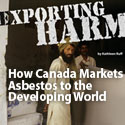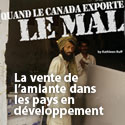Kathleen Ruff, RightOnCanada.ca
The International Chrysotile Association (ICA) promotes the asbestos trade. Its Board of Directors is comprised of representatives of asbestos mines in Russia, Kazakhstan, Brazil, a closed asbestos mine in Zimbabwe, and asbestos industrialists in India, and Mexico. Chrysotile asbestos represents 100% of the global asbestos trade.
The ICA is registered in and operates out of Quebec. Its President, Jean-Marc Leblond, worked for decades to sell Quebec asbestos around the world until the Quebec asbestos mines lost the political and economic support of the Quebec government in 2012 and shut down.
Like the Tobacco Institute, on which it is modelled, the ICA has no scientific credentials. It claims that scientific articles support the use of chrysotile asbestos. It fails to mention that the ICA financed and works closely with the authors of these articles and that the work of these authors has been rejected by the world scientific community.
The Rotterdam Convention governs trade in hazardous substances
Two weeks before the 8th Conference of the Parties (COP8) to the Rotterdam Convention takes place in Geneva April 24 to May 5, 2017, the ICA has released a report entitled Rotterdam Convention – COP8 Meeting – 2017 and is calling for the defeat of the recommendation of the Convention’s expert scientific committee to put chrysotile asbestos on the Convention’s list of hazardous substances.
The ICA is also seeking to defeat a proposal by a dozen African countries to amend the Rotterdam Convention so as to allow a ¾ majority vote to list hazardous substances, if consensus proves impossible.
For more than a decade, a handful of countries involved in the asbestos trade, supported by the ICA, have blocked the listing of chrysotile asbestos by refusing consensus at the COPs, using false and misleading information, such as the ICA is disseminating in its COP8 report.
Here are some examples of false information in the ICA Rotterdam Convention – COP8 Meeting – 2017 document.
Denying the rights of countries in the global South
What the ICA says:
The ICA says it opposes the listing of chrysotile asbestos because it wants to support the democratic rights and the well-being of countries in the global South.
The Reality:
The Rotterdam Convention imposes an obligation on countries exporting hazardous substances and it provides the basic human right of Prior Informed Consent to countries in the global South, empowering them to control how and if hazardous substances can be shipped into their countries so they can better protect their population and environment.
It is indefensible that the ICA, representing the interests of asbestos sellers, refuses to accept its legal obligations under the Convention and instead continues to deny countries in the global South a right which to which they are entitled under the Convention.
Blocking the listing of chrysotile asbestos on the Convention’s list of hazardous substances
What the ICA says:
The ICA makes accusations that wrongdoing is involved in the efforts to list chrysotile asbestos under the Convention.
The Reality:
The criteria for listing a substance under the Convention are that the substance has been banned or severely restricted in two countries in different regions of the world in order to protect human and environmental health and that the Convention’s Chemical Review Committee, made up of 32 scientists from all regions of the world, after reviewing the evidence, determine that the substance meets the Convention’s criteria for listing and submits a recommendation to the COP that it be put on the Convention’s list (Annex III).
The Chemical Review Committee has submitted the recommendation to list chrysotile asbestos at every COP for more than a decade. The COP has agreed that chrysotile asbestos meets all the criteria for listing.
A tiny number of countries with financial interests in the asbestos trade, led first by then asbestos-exporter Canada, and now by asbestos-exporters Russia and Kazakhstan, have abused the requirement for a consensus decision to list a substance and have introduced arguments that are extraneous to the Convention in order to block its listing and to divert attention from the clear fact that, under the criteria of the Convention, chrysotile asbestos should be listed.
Scientific evidence of harm caused by chrysotile asbestos
What the ICA says:
The ICA claims that recent scientific evidence says that chrysotile asbestos poses negligible risks to health and can be safely used.
The Reality:
Not a single reputable scientific body in the world supports what the ICA claims. As just one example, the Statement on Asbestos by the International Joint Policy Committee of the Societies of Epidemiology, endorsed by scientists and public interest groups around the world, rejects the claims made by the ICA, stating: “Independent and reputable scientific authorities reject these claims as erroneous, dangerous, and deceptive.”
Every scientific organisation that has examined the asbestos issue – The Union for the International Control of Cancer (2012), comprising more than 700 member organisations in 155 countries, the World Federation of Public Health Associations (2005), the International Commission on Occupational Health (2000), the International Social Security Association (2004), the Collegium Ramazzini (1999, 2010) and the International Trade Union Confederation (2004) – have all dismissed the claims of the ICA as having no credibility.
Which countries import chrysotile asbestos?
What the ICA says:
The ICA says that two thirds of humanity use chrysotile asbestos.
The Reality:
Just two countries – India and Indonesia – import over 50% of all asbestos imported in the world
Of the 196 countries in the world, just 17 countries account for 95% of all imported asbestos (Data from Estimates of Global Asbestos Production, Trade, & Consumption in 2015, United States Geological Survey).
IMPORT OF CHRYSOTILE ASBESTOS, 2015 (metric tons):
India 318,670
Indonesia 120,458
China 108,895*
Vietnam 61,282
Uzbekistan 56,051
Thailand 36,513
Sri Lanka 34,505
Mexico 12,077
Turkmenistan 4,788
Colombia 4,770
Bolivia 4,168
Cuba 4,095
Kyrgyzstan 4,451
Ecuador 3,980
Malaysia 2,977
Pakistan 2,858
Philippines 1,775
TOTAL: 782,313 metric tons
*Note: China mines and is a net importer of asbestos. It mined 210,000 tons, imported 108,895 tons and exported 31,632 tons of chrysotile asbestos in 2015.
The total amount of asbestos imported globally in 2015 was 824,557 metric tones. The above 17 countries represent 95% of total global asbestos imports.
The asbestos mining companies in Russia, Kazakhstan and Brazil, whose interests the ICA represents, are determined to vastly increase their export of asbestos to the global South, particularly to Asia. The way they plan to do this is by denying that chrysotile asbestos is hazardous. They are therefore determined to prevent chrysotile asbestos from being put on the Convention`s list of hazardous substances.
Ending the global double standard
The Rotterdam Convention was specifically created to address the double standard whereby hazardous chemicals and pesticides that are banned or severely restricted in industrialized countries are increasingly being shipped to developing countries and countries with economies in transition.
Thus, as populations in the global North gain greater protection from harm from hazardous substances, populations in the global South are increasingly exposed to such harm. This is immoral and unjust.
The Rotterdam Convention seeks to stop this double standard by empowering countries with the right to Prior Informed Consent.
All Parties to the Convention have a legal and moral obligation to allow the right to Prior Informed Consent, contained in the Convention, to be implemented.
A right that is not implemented is worthless.



Mon, Apr 10, 2017
Asbestos